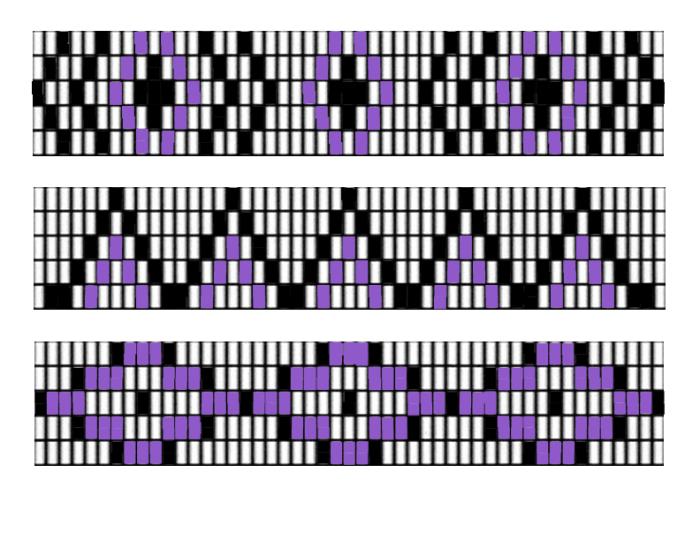Wampum Armband or Bracelet
This is a project to make armbands or bracelets inspired by the Wampanoag people’s traditional art of wampum.

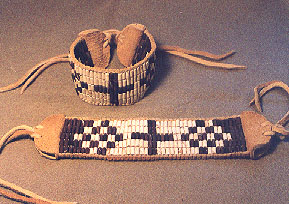
What is Wampum?
Wampum are the traditional sacred shell beads of many Native American Tribes. Some of these wampum shell beads have been found in the Northeast and are over 4500 years old.
The word "wampum" comes from the Algonquin language which the Wampanoag people of the “First Thanksgiving” spoke. It is a shortened version the word “wampumpeag” meaning white shell bead. There are basically two colors of beads : The white beads are called “wampi” and come from the inner part of the Whelk shell. The purple beads are called “saki” and come from quahog shells.
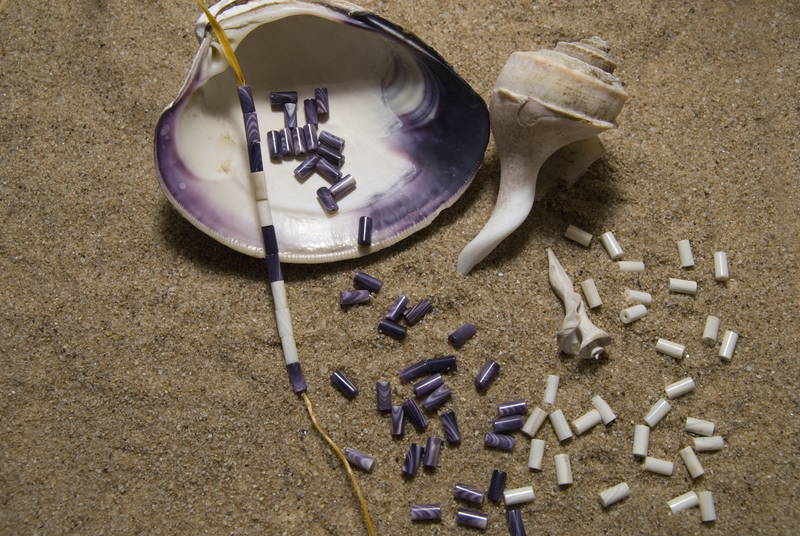
Wampum beads were exhanged among Native people for their value as connections with water and its life giving properties. Water is considered the “first medicine” among many Native people. Representing this spiritual connection to water, these beads are sewn on to ceremonial dress and other clothing. They are also woven to make bracelets, necklaces, earrings and into belts where the designs tell a story to anyone who knows how to read them.
Joan LeLacheur an Aquinnah Wampanoag artist states: "The quahog [wampum shell] is everything - food, work, water, a way of life, a beautiful form, and then a treasure to be touched, worn, and shared."
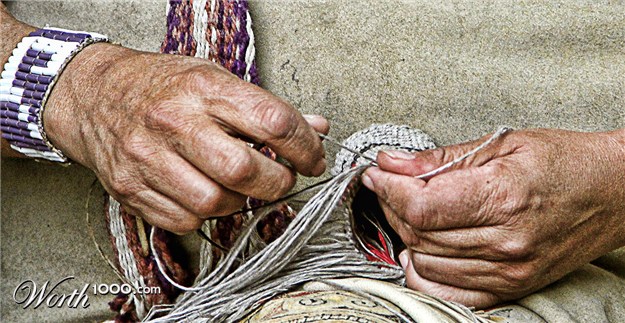
Jonathan Perry another Aquinnah Wampanoag Tribal member explains: “ "The Wampanoag, the Narragansett, the Niantic, and the Pequot - those were the four nations really heavily involved in the shell trade... We made art work: belts, crowns, earrings. We also stitched plates and tubular beads to our clothing... The purple represents the eyes of our ancestors, the accrued knowledge over generations; white is said to represent health - spiritual, physical, and mental health."
Wampum was never used as a form of money among any Native Americans. It was the Europeans who began to use wampum for money. There was a shortage of coins so wampum took the place of money. In fact, wampum was legal tender [money] in all 13 original Colonies. The value of this money was 6 white or 3 purple wampum beads equaled a penny. Because wampum was used as money, the Dutch colonists began to mass produce it. John Campbell, a Dutchman, established a factory in Passaic, New Jersey which manufactured wampum into the early 1900’s.
_________________________________________
Wampum Arm Band or Bracelet - OUR PROJECT
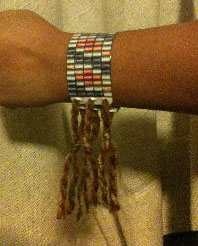
This is a sample photo of what your bracelet could look like
SUPPLIES
Plain paper
Crayons, colored pencils or markers
Glue or glue stick
Clear packing tape as a protective covering (optional)
Push Pin, small nail, or large needle to make holes
Paper plate or piece of cardboard as a cushion for punching holes.
Yarn needle for getting the yarn ties through the holes (optional)
Yarn
Beads with large holes (optional)
INSTRUCTIONS
Print a copy of the wampum pattern and end pieces. (Patterns and all other materials are at the bottom of this page.)
Measuring:
Cut a narrow strip from the long side of a plain sheet of 8.5 x 11 paper. This will be used to measure your wrist or arm or neck. (A bracelet will go around your wrist. An arm band will go around your arm above the elbow. (In Native culture bracelets and armbands can be worn by both males and females they are not gender specific.)
Next, wrap the paper around your wrist or your arm and mark it to measure the length. I usually crimp the paper or make a little fold rather than marking it with a pencil or pen.
Lay this over the printed copy of the wampum pattern, notice where your measurement is on the pattern, then subtract three beads from the pattern and cut them off. This will make it slightly smaller than your actual measurement. This makes room for the extra length that will occur when you attach the end pieces.
Coloring:
Color the beads in a pattern from our examples below or create your own pattern.
Assembly:
Optional - Clear packing tape can be used to laminate the colored wampum pattern. Unroll enough tape to go past the edges of your wampum pattern and cut the tape. Place the tape sticky side up and then carefully place your pattern colored side down on the tape. Trim off the extra tape.
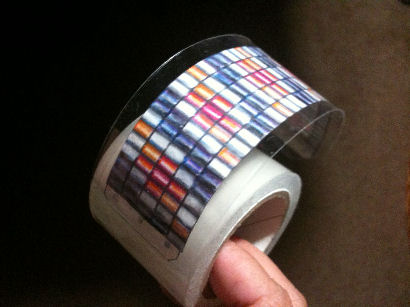
The next step is to cut out two of the end pieces that were printed with the wampum pattern. Color these and then fold them in half and glue the undersides together. Then glue the end tabs under the ends of your colored wampum pattern. If you used tape to cover your pattern, use some more tape and tape the end pieces on the underside of your pattern.
Punching the holes in the end pieces - Be sure to place something thick under your end pieces to protect the surface of your work area. Cardboard from a packing or pizza box, or several paper or styrofoam plates stacked together. Punch holes where marked on the end pieces.
Cut six 10 inch lengths of thread. Thread the yarn on a needle or take a little glue and put it on the ends of the yarn, twist to make the yarn narrow, then let it dry. When dry, the ends will be hard enough to push through the holes. If you use this method punch bigger holes in the end pieces with something like a large nail or awl. After the yarn is through the holes, pull them so they meet in the middle and are equal lengths. Knot them so they stay in place.
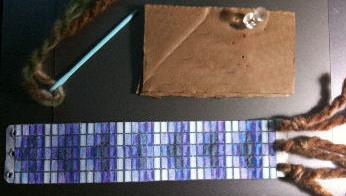
Wearing your bracelet or arm band:
Put the armband or bracelet on and tie the yarn so that it fits snugly on your wrist or arm. You can add beads to the ends of the yarn so it dangles better. If you use beads make sure the beads you purchase have large enough holes to allow for the thickness of the yarn. Pony beads or crow beads are usually just right. They can be purchased at most craft stores.
Template pieces for armband/bracelet - print at full size
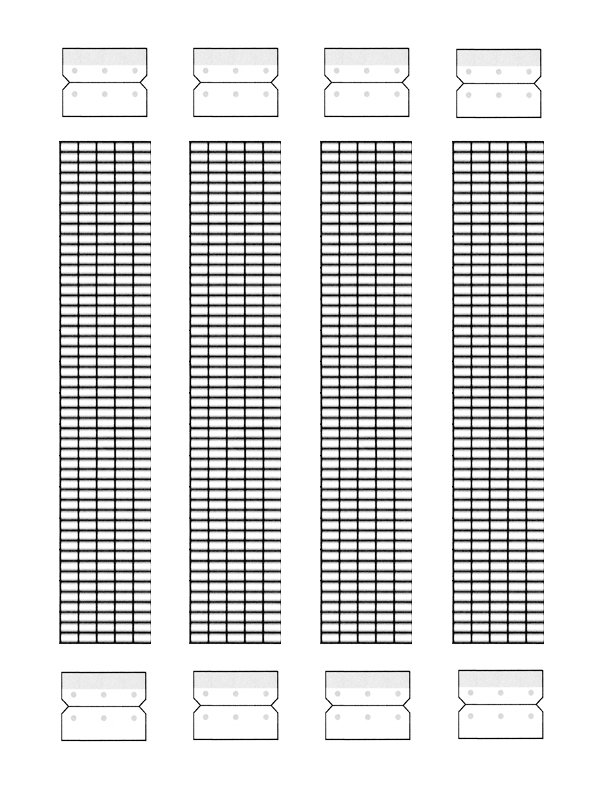
Here's the wampum bracelet armband pattern is in PDF format
Samples of patterns
